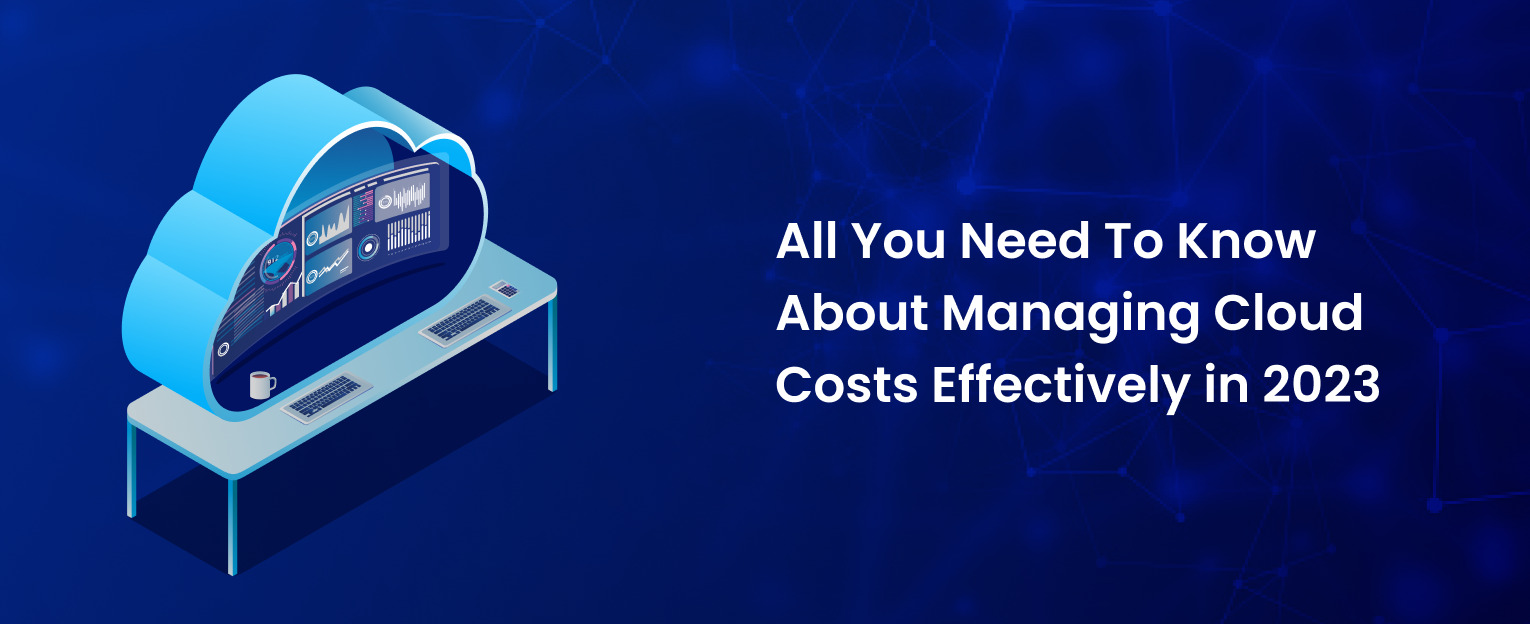The cloud has become an integral part of many organizations’ development and operations, and as more businesses move to the cloud, managing cloud costs is becoming increasingly important.
Cloud costs can quickly spiral out of control if you don’t take steps to manage them effectively. This article will look at best practices for controlling your cloud costs in 2024 and beyond.
- In 2020, the global cloud computing market was valued at $257 billion and was expected to reach nearly $536 billion by 2024.
- As cloud adoption continues to rise, so do its costs.
- According to IDC research, up to 60% of the cost of running a cloud infrastructure can be attributed to inefficient cloud cost management.
So, as businesses look forward to the New Year and into 2023, cloud cost management should be top of their list. Cloud-based services are becoming more popular, with companies of all sizes relying on the cloud for everything from file storage to AI processing.
Unsurprisingly, the costs associated with using public cloud infrastructure can become too expensive to manage, making cloud cost optimization a priority. The good news is that there are best practices that can be followed to optimize and manage cloud costs so businesses can get the most out of their public cloud services while still staying within budget. Read on to learn 10 best practices for how to manage cloud costs in 2023.
What is Cloud Cost Optimization?
Cloud cost optimization is an essential part of FinOps, a business practice that combines control over the variable spending model and financial accountability in cloud IaaS.
Optimizing cloud costs requires businesses to have a deep understanding of two areas:
- Intelligent procurement of cloud services: To maximize savings, businesses should take advantage of programs like AWS Savings Plans and capacity reservations such as Amazon Reserved Instances.
- Intelligent optimization of cloud capacity: Organizations need to identify the optimal instance and resource configuration for their workloads to maximize cloud efficiency.
By intelligently managing cost of cloud services, businesses can achieve a better balance between cost efficiency and performance.
Optimize Your Cloud Costs Now!
Don’t let your cloud costs spiral out of control. Our cloud consulting experts can help you manage your cloud infrastructure more effectively, saving you time and money. Contact us today to optimize your cloud costs and improve your bottom line.
Getting Started With Cloud Cost Management
The most effective way for businesses to manage cloud costs is by following core strategies. These approaches bridge the gap between financial accountability and cloud cost optimization, allowing organizations to take control of their cloud spending and start saving on their infrastructure expenses today.
Some imperative strategies for cloud cost optimization include:
- Rightsizing to ensure that the resources used are adequate for their workloads and can reduce costs.
- Utilizing Reserved Instances and Savings Plans to take advantage of discounts.
- It identifies and resolves hidden line items that may secretly contribute to the excess cost of cloud services.
- Developing a culture of cost consciousness throughout the organization.
- They are leveraging analytics to gain insight into cloud usage and optimize costs.
Successful enterprises must establish good practices when operating in the cloud. To raise cloud service costs awareness and optimize costs, businesses should dedicate a technical team of cloud Advisors to help tune their cloud operating models and FinOps practices.
This dedicated team can assist organizations with developing proper measures to manage cloud costs and reduce their overall cloud overspend. Additionally, they can help companies interpret their AWS cost and usage reports to understand better how they use cloud services.
By taking a proactive approach to cloud cost optimization, businesses can save money while still getting the most out of their public cloud services.
With the right resources and guidance on how to manage the cloud, organizations can ensure that they are running efficiently in the cloud while also staying within budget.
Cloud Cost Optimization: 10 Best Practices for FinOps
Below are a few strategies that can be implemented to help businesses reach their cost optimization goals in 2023:
1. Right-Sizing Compute Resources
Right-sizing computes resources proactively is essential for businesses looking to reduce cloud costs. With AWS offering over 300 different instance types, selecting the most appropriate one can be a daunting, even for experienced cloud architects.
To ensure that they are using the right instance size and family, organizations should leverage automated services such as AWS Optimization Advisor to identify areas of potential improvement.
Additionally, they should consider using cloud cost optimization tools to analyze and assess their current instance selection and recommend the best instances for their workloads.
2. Monitoring Cost Anomalies And Identifying Hidden Charges
Organizations should monitor their cloud costs wherever possible for any unexpected anomalies or hidden charges wherever possible. Automated tools can review cost and usage reports regularly and identify areas where they may be overspending. Additionally, they should take the time to thoroughly review their bills each month and investigate any sudden spikes in their costs. The ability to quickly detect and address any anomalies is key for businesses in controlling their advisory cloud pricing.
3. Picking Up The Right Storage Type
Amazon S3 is widely used for cloud storage and has become a leading service for businesses operating in the cloud. But, when it comes to controlling costs on S3, organizations should be aware of the various tiers available from AWS.
By carefully assessing their current storage buckets and determining which ones are frequently or infrequently accessed, enterprises can leverage the right storage type for their needs, saving money in the long run.
Also, businesses should take advantage of S3 Intelligent Tiering to help automate data lifecycle management and optimize costs.
4. Release Idle Elastic IP Addresses
Idle Elastic IP addresses can lead to unnecessary costs for businesses running in the cloud. To avoid these charges, organizations should keep an eye out for unused or idle Elastic IPs and promptly release them when not needed.
Leveraging cloud cost intelligence services can help automate this process by actively monitoring their environment and alerting them of any idle or unused IP addresses. With this approach, businesses can rest assured that their accounts are not accumulating charges from idle Elastic IPs.
5. Automate Infrastructure Rightsizing During Provisioning
Businesses looking to optimize their cloud costing should leverage Infrastructure as Code (IaC) tools such as AWS CloudFormation or HashiCorp Terraform for automated infrastructure provisioning. With the right automation, organizations can ensure they are rightsizing their instances correctly and avoiding manual errors.
Furthermore, businesses should incorporate cost optimization practices into their CI/CD pipeline, such as leveraging AWS Optimization Advisor to identify areas of potential improvement. This way, they can proactively manage their cloud deployments and ensure they are using the right instances for their workloads.
6. Leverage Software Licensing Spend
With the ever-growing range of software available on the AWS Marketplace, businesses can maximize their AWS usage by leveraging their existing software licenses. With the help of automated cloud cost management tools, organizations can interpret their cost and usage reports to identify which AMIs are using licensed software and ensure that they are taking full advantage of their existing licenses.
By reviewing their bills each month and identifying potential improvement areas, businesses can ensure that they are making the most out of their software licensing spend in the cloud.
7. Pausing Your Idle Redshift Clusters When Not In Use
With AWS Redshift, businesses can easily spin up data warehousing clusters in the cloud. But, when running Redshift on demand, organizations continue to pay for compute nodes even when their clusters are idle.
To ensure that they aren’t incurring unnecessary costs due to idle resources, an advantage of features such as pause and resume functionality is to shut down clusters when they are not in use.
Moreover, leveraging cloud cost optimization tools can help automate the process of pausing idle clusters and ensure that your organization takes full advantage of Redshift’s cost savings.
8. Delete Unused EBS Snapshot
Proactively taking EBS snapshots is a great way to ensure robust disaster recovery planning and data protection in the cloud. However, failing to monitor and delete unused snapshots can lead to increased storage costs in S3 over time.
To address this issue, organizations should use cloud cost management tools to proactively monitor their snapshot inventory and delete idle or unused ones. With a comprehensive monitoring strategy in place, businesses can ensure that they are making the most of their S3 storage costs while still protecting their data in the cloud and managing cloud costs.
9. Monitor And Control Your AWS Elastic IP Addresses
Organizations that use many AWS services often accumulate large numbers of Elastic IP addresses over time. While these are useful for managing instance failover, businesses can incur charges for unused or idle IPs. To avoid incurring additional costs, businesses should regularly review their IP inventory and delete unused ones.
Not only that, but they should also take advantage of AWS EC2 tools such as Elastic IP Auto assignment and Elastic IP Address allocation to effectively manage their IPs. By leveraging these tools, businesses can ensure that their address pools are optimized for cost while allowing them to manage instance failover easily.
10. Build A Culture Of Cost Awareness
Lastly, organizations should strive to build a culture of cost awareness. This requires establishing standardized cloud best practices and Cloud Operating Models across teams. To accelerate this cultural shift, businesses should use cloud cost optimization tools that provide differentiated reporting to raise cost visibility cross-functionally.
These reports can help expose hidden waste and dangerous spending patterns, enabling decision-makers to make more informed decisions about cloud usage. With a cost-conscious culture, businesses can take full advantage of the cloud’s cost savings while still delivering the best possible customer experience.
How To Manage And Optimize Costs Of Public Cloud IaaS And PaaS?
Above mentioned strategies are a great starting point to help you know how to manage the cloud and optimize cloud costs; however, they may not be enough to unlock the full potential of cost savings.
Organizations should consider leveraging dedicated cloud cost optimization tools to optimize and manage their public cloud IaaS and PaaS expenses.
By leveraging these tools, organizations can gain deep insights into their usage patterns and take proactive steps to control their public cloud IaaS and PaaS expenses. It will enable them to maximize their cost savings while delivering the best customer experience.
Best Practices For Reducing Your Cloud Bills
Organizations that proactively and holistically manage their cloud environments get the most cloud for each dollar spent and ensure ongoing, cost-effective cloud operations. To achieve this goal, businesses should establish a comprehensive strategy to maximize the benefits of the cloud while minimizing unnecessary costs.
Wrapping It Up!
By following the above best practices and leveraging cloud cost optimization tools, organizations can ensure that their cloud bills are consistently optimized for performance and cost. But remember, controlling cloud service costs is an ongoing process – businesses should regularly review their resource utilization and adjust their strategy accordingly.
Therefore, it’s important to stay vigilant and use cloud cost optimization tools to identify suboptimal provisioning, ensure that the most efficient instance types are used, and take advantage of the granular cost breakdowns provided. By doing so, businesses can ensure they’re getting the most out of their investments in the cloud.







